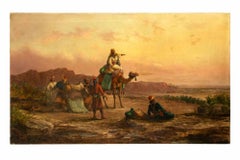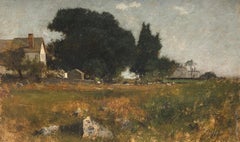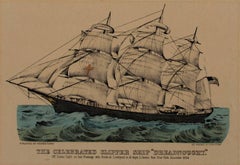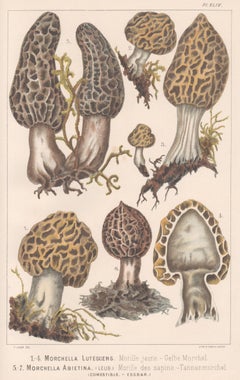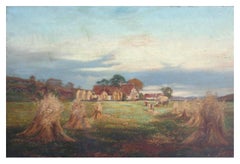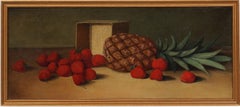Late 19th Century Art
to
970
4,684
1,448
990
422
490
Overall Width
to
Overall Height
to
7,523
20,755
156,543
236,316
1,895
2,280
4,829
6,431
5,916
13,280
20,381
25,122
17,348
13,318
5,321
1,964
703
205
111
34
33
24
11
8
3
2
1
4,313
3,349
41
4,672
2,295
1,508
1,199
1,193
930
698
552
535
515
474
385
359
347
340
309
288
254
248
228
3,070
2,221
1,878
1,204
1,089
75
72
49
44
43
2,832
2,427
3,999
2,873
Period: Late 19th Century
Pilgrims Halting near Cairo - Oil Paint by Howard Hunt - Late 19th Century
Located in Roma, IT
Pilgrims halting near Cairo is an artwork realized by Howard Hunt.
Signed lower right.
At the back titled and signed.
127 x 76 cm.
Good conditions
Category
Modern Late 19th Century Art
Materials
Canvas, Oil
New England Farmhouse
Located in Bryn Mawr, PA
Provenance
The artist;
By descent in the family to the artist's great-grandaughter, until 2023
Born on a small island near Martha's Vineyard, R. Swain Gifford and his family moved t...
Category
Barbizon School Late 19th Century Art
Materials
Canvas, Oil
19th century color lithograph seascape boat ship waves maritime landscape
Located in Milwaukee, WI
"The Celebrated Clipper Ship Dreadnought" is an original hand-colored lithograph by Currier & Ives. It depicts a sailing ship.
13 1/4" x 17 1/2" art
19" x 23 1/2" frame
Nathaniel Currier was a tall introspective man with a melancholy nature. He could captivate people with his piercing stare or charm them with his sparkling blue eyes. Nathaniel was born in Roxbury, Massachusetts on March 27th, 1813, the second of four children. His parents, Nathaniel and Hannah Currier, were distant cousins who lived a humble yet spartan life. When Nathaniel was eight years old, tragedy struck. Nathaniel’s father unexpectedly passed away leaving Nathaniel and his eleven-year-old brother Lorenzo to provide for the family. In addition to their mother, Nathaniel and Lorenzo had to care for six-year-old sister Elizabeth and two-year-old brother Charles. Nathaniel worked a series of odd jobs to support the family, and at fifteen, he started what would become a life-long career when he apprenticed in the Boston lithography shop of William and John Pendleton.
A Bavarian gentleman named Alois Senefelder invented lithography just 30 years prior to young Nat Currier’s apprenticeship. While under the employ of the brothers Pendleton, Nat was taught the art of lithography by the firm’s chief printer, a French national named Dubois, who brought the lithography trade to America.
Lithography involves grinding a piece of limestone flat and smooth then drawing in mirror image on the stone with a special grease pencil. After the image is completed, the stone is etched with a solution of aqua fortis leaving the greased areas in slight relief. Water is then used to wet the stone and greased-ink is rolled onto the raised areas. Since grease and water do not mix, the greased-ink is repelled by the moisture on the stone and clings to the original grease pencil lines. The stone is then placed in a press and used as a printing block to impart black on white images to paper.
In 1833, now twenty-years old and an accomplished lithographer, Nat Currier left Boston and moved to Philadelphia to do contract work for M.E.D. Brown, a noted engraver and printer. With the promise of good money, Currier hired on to help Brown prepare lithographic stones of scientific images for the American Journal of Sciences and Arts. When Nat completed the contract work in 1834, he traveled to New York City to work once again for his mentor John Pendleton, who was now operating his own shop located at 137 Broadway. Soon after the reunion, Pendleton expressed an interest in returning to Boston and offered to sell his print shop to Currier. Young Nat did not have the financial resources to buy the shop, but being the resourceful type he found another local printer by the name of Stodart. Together they bought Pendleton’s business.
The firm ‘Currier & Stodart’ specialized in "job" printing. They produced many different types of printed items, most notably music manuscripts for local publishers. By 1835, Stodart was frustrated that the business was not making enough money and he ended the partnership, taking his investment with him. With little more than some lithographic stones, and a talent for his trade, twenty-two year old Nat Currier set up shop in a temporary office at 1 Wall Street in New York City. He named his new enterprise ‘N. Currier, Lithographer’
Nathaniel continued as a job printer and duplicated everything from music sheets to architectural plans. He experimented with portraits, disaster scenes and memorial prints, and any thing that he could sell to the public from tables in front of his shop. During 1835 he produced a disaster print Ruins of the Planter's Hotel, New Orleans, which fell at two O’clock on the Morning of the 15th of May 1835, burying 50 persons, 40 of whom Escaped with their Lives. The public had a thirst for newsworthy events, and newspapers of the day did not include pictures. By producing this print, Nat gave the public a new way to “see” the news. The print sold reasonably well, an important fact that was not lost on Currier.
Nat met and married Eliza Farnsworth in 1840. He also produced a print that same year titled Awful Conflagration of the Steamboat Lexington in Long Island Sound on Monday Evening, January 18, 1840, by which melancholy occurrence over One Hundred Persons Perished. This print sold out very quickly, and Currier was approached by an enterprising publication who contracted him to print a single sheet addition of their paper, the New York Sun. This single page paper is presumed to be the first illustrated newspaper ever published.
The success of the Lexington print launched his career nationally and put him in a position to finally lift his family up. In 1841, Nat and Eliza had their first child, a son they named Edward West Currier. That same year Nat hired his twenty-one year old brother Charles and taught him the lithography trade, he also hired his artistically inclined brother Lorenzo to travel out west and make sketches of the new frontier as material for future prints. Charles worked for the firm on and off over the years, and invented a new type of lithographic crayon which he patented and named the Crayola. Lorenzo continued selling sketches to Nat for the next few years.
In 1843, Nat and Eliza had a daughter, Eliza West Currier, but tragedy struck in early 1847 when their young daughter died from a prolonged illness. Nat and Eliza were grief stricken, and Eliza, driven by despair, gave up on life and passed away just four months after her daughter’s death.
The subject of Nat Currier’s artwork changed following the death of his wife and daughter, and he produced many memorial prints and sentimental prints during the late 1840s. The memorial prints generally depicted grief stricken families posed by gravestones (the stones were left blank so the purchasers could fill in the names of the dearly departed). The sentimental prints usually depicted idealized portraits of women and children, titled with popular Christian names of the day.
Late in 1847, Nat Currier married Lura Ormsbee, a friend of the family. Lura was a self-sufficient woman, and she immediately set out to help Nat raise six-year-old Edward and get their house in order. In 1849, Lura delivered a son, Walter Black Currier, but fate dealt them a blow when young Walter died one year later. While Nat and Lura were grieving the loss of their new son, word came from San Francisco that Nat’s brother Lorenzo had also passed away from a brief illness. Nat sank deeper into his natural quiet melancholy. Friends stopped by to console the couple, and Lura began to set an extra place at their table for these unexpected guests. She continued this tradition throughout their lives.
In 1852, Charles introduced a friend, James Merritt Ives, to Nat and suggested he hire him as a bookkeeper. Jim Ives was a native New Yorker born in 1824 and raised on the grounds of Bellevue Hospital where his father was employed as superintendent. Jim was a self-trained artist and professional bookkeeper. He was also a plump and jovial man, presenting the exact opposite image of his new boss.
Jim Ives met Charles Currier through Caroline Clark, the object of Jim’s affection. Caroline’s sister Elizabeth was married to Charles, and Caroline was a close friend of the Currier family. Jim eventually proposed marriage to Caroline and solicited an introduction to Nat Currier, through Charles, in hopes of securing a more stable income to support his future wife.
Ives quickly set out to improve and modernize his new employer’s bookkeeping methods. He reorganized the firm’s sizable inventory, and used his artistic skills to streamline the firm’s production methods. By 1857, Nathaniel had become so dependent on Jims’ skills and initiative that he offered him a full partnership in the firm and appointed him general manager. The two men chose the name ‘Currier & Ives’ for the new partnership, and became close friends.
Currier & Ives produced their prints in a building at 33 Spruce Street where they occupied the third, fourth and fifth floors. The third floor was devoted to the hand operated printing presses that were built by Nat's cousin, Cyrus Currier, at his shop Cyrus Currier & Sons in Newark, NJ. The fourth floor found the artists, lithographers and the stone grinders at work. The fifth floor housed the coloring department, and was one of the earliest production lines in the country. The colorists were generally immigrant girls, mostly German, who came to America with some formal artistic training. Each colorist was responsible for adding a single color to a print. As a colorist finished applying their color, the print was passed down the line to the next colorist to add their color. The colorists worked from a master print displayed above their table, which showed where the proper colors were to be placed. At the end of the table was a touch up artist who checked the prints for quality, touching-in areas that may have been missed as it passed down the line. During the Civil War, demand for prints became so great that coloring stencils were developed to speed up production.
Although most Currier & Ives prints were colored in house, some were sent out to contract artists. The rate Currier & Ives paid these artists for coloring work was one dollar per one hundred small folios (a penny a print) and one dollar per one dozen large folios. Currier & Ives also offered uncolored prints to dealers, with instructions (included on the price list) on how to 'prepare the prints for coloring.' In addition, schools could order uncolored prints from the firm’s catalogue to use in their painting classes.
Nathaniel Currier and James Merritt Ives attracted a wide circle of friends during their years in business. Some of their more famous acquaintances included Horace Greeley, Phineas T. Barnum, and the outspoken abolitionists Rev. Henry Ward, and John Greenleaf Whittier (the latter being a cousin of Mr. Currier).
Nat Currier and Jim Ives described their business as "Publishers of Cheap and Popular Pictures" and produced many categories of prints. These included Disaster Scenes, Sentimental Images, Sports, Humor, Hunting Scenes, Politics, Religion, City and Rural Scenes, Trains, Ships, Fire Fighters, Famous Race Horses, Historical Portraits, and just about any other topic that satisfied the general public's taste. In all, the firm produced in excess of 7500 different titles, totaling over one million prints produced from 1835 to 1907.
Nat Currier retired in 1880, and signed over his share of the firm to his son Edward. Nat died eight years later at his summer home 'Lion’s Gate' in Amesbury, Massachusetts. Jim Ives remained active in the firm until his death in 1895, when his share of the firm passed to his eldest son, Chauncey.
In 1902, faced will failing health from the ravages of Tuberculosis, Edward Currier sold his share of the firm to Chauncey Ives...
Category
Other Art Style Late 19th Century Art
Materials
Lithograph
Morchella Lutescens, Leuba antique mushroom morel fungi chromolithograph print
Located in Melbourne, Victoria
'1-4 Morchella Lutescens 5-7 Morchella Abietina'
Antique Swiss mushroom / fungi chromolithograph, lithographed by H Furrer after Fritz Leuba. The print is titled with the scientific...
Category
Naturalistic Late 19th Century Art
Materials
Lithograph
Late 19th Century Scottish Figural Landscape, "The Ingathering, Rowan Tree Hill"
Located in Soquel, CA
A sweeping skyline sets a gentle tone for this late 19th century Scottish pastoral scene titled on verso "The Ingathering, Rowan-Tree Hill, Kilmalcol...
Category
Impressionist Late 19th Century Art
Materials
Canvas, Oil
Antique American Oil Painting Framed Fruit Table Still Life Pineapple Strawberry
Located in Buffalo, NY
Incredible early American realist still life featuring pineapple and strawberries on a table. Oil on canvas. Incredible detail and masterfully painted.
Signed illegibly, last n...
Category
American Realist Late 19th Century Art
Materials
Canvas, Oil
$1,196 Sale Price
20% Off
"Medieval Thoughts, Prague, " Alphonse Mucha, Czech Art Nouveau Illustration
Located in New York, NY
Alphonse Mucha (Czech, 1860 - 1939)
Medieval Thoughts, circa 1890
Wash, ink, and watercolor on paper
11 x 9 inches
Signed lower right
Provenance:
Phillips New York, 19th and 20th ce...
Category
Art Nouveau Late 19th Century Art
Materials
Paper, Ink, Watercolor
Queen's Amaryllis - Lithograph by Vincenzo Tenore - 1870s
Located in Roma, IT
Lithograph hand watercolored.
Belongs to the Series "Atlante di Botanica popolare ossia Illustrazione di Piante Notevoli di ogni famiglia" (Atlas of popular botany or illustration o...
Category
Modern Late 19th Century Art
Materials
Lithograph
Sunset on the Alps
Located in Cotignac, FR
Late 19th century drawing and crayon view of a sunset over the Alps by Hercules Brabazon Brabazon. Initial signed (HBB) by the artist.
Brabazon would have vi...
Category
Impressionist Late 19th Century Art
Materials
Paper, Pencil, Crayon
Pulmonaria, English antique blue pink flower botanical chromolithograph, 1895
By Frederick William Hulme
Located in Melbourne, Victoria
'Pulmonaria'
Process print from Frederick William Hulme’s ‘Familiar Wild Flowers’, circa 1890.
Hulme was known as a teacher and an amateur botanist. He was the Professor of Freehan...
Category
Naturalistic Late 19th Century Art
Materials
Lithograph
French Orientalist watercolour by Émile Boivin
Located in London, GB
French Orientalist watercolour by Émile Boivin
French, late 19th Century
Frame: Height 33cm, width 39.5cm, depth 3cm
Sheet: Height 23cm, width 29.5cm
Thi...
Category
Late 19th Century Art
Materials
Watercolor
Russian, French antique 19th century Racinet art design lithograph print
Located in Melbourne, Victoria
'Russian - Russe - Russisch'
Late 19th century interior design chromolithograph, from Racinet’s ‘L’Ornement Polychrome’, 1887. Published in Paris.
Albert Racinet's 'L' Ornement Pol...
Category
French School Late 19th Century Art
Materials
Lithograph
Apocalypse de Saint Jean - Lithographs on Chine collé by Odilon Redon - 1899
By Odilon Redon
Located in Roma, IT
Apocalypse de Saint Jean is a complete suite of 13 b/w lithographs (cover + 12 lithographs) on Chine collé , realized by Odilon Redon. All the lithographs are unsigned, as issued.
P...
Category
Symbolist Late 19th Century Art
Materials
Lithograph
Naturalistic British painter - 19th century landscape painting - Bulls at river
Located in Varmo, IT
English painter (19th century) - Bulls at the stream.
35 x 54 cm without frame, 44.5 x 62.5 cm with frame.
Oil on panel, in a gilded wooden frame (not ...
Category
Naturalistic Late 19th Century Art
Materials
Oil, Panel
$711 Sale Price
60% Off
The Cliffs Of Treport - Normandy Etretat, oil on wood by Léon Richet
By Leon Richet
Located in PARIS, FR
Conditions : Excellent overall with a genuine oil on board with original period frame.
Minor 3 mm retouching under UV light. (As seen on picture)
A student of Narcisse Diaz de la P...
Category
Impressionist Late 19th Century Art
Materials
Oil
John Francis Branegan (1843-1909) - Framed Watercolour, Evening on the Medway
Located in Corsham, GB
John Francis Branegan (1843-1909) - original watercolour. Evening on the Medway. Signed and inscribed to the lower right. Presented in a gilt-effect frame with a wash-line mount. Lab...
Category
Late 19th Century Art
Materials
Watercolor
Vanity Fair Caricature, Rev. Edgar Sheppard "A Great Marrier" by Spy
Located in Alamo, CA
Vanity Fair color chromolithograph caricature of Rev. Edgar Sheppard "A Great Marrier" by Spy (Leslie Ward) March 14, 1904 from the "Clergymen" series....
Category
Victorian Late 19th Century Art
Materials
Lithograph
Middle Ages, French antique 19th century Racinet art design lithograph print
Located in Melbourne, Victoria
'Middle Ages - Moyen-Age - Mittel Alter'
Late 19th century interior design chromolithograph, from Racinet’s ‘L’Ornement Polychrome’, 1887. Published in Paris.
Albert Racinet's 'L' ...
Category
French School Late 19th Century Art
Materials
Lithograph
Awabi Diver with shell - Japanese Woodblock print by Kitagawa Utamaro
Located in Greenwich, CT
Utamaro Kitagawa – active ca. 1753-1806
Woodblock Print
title : Awabi Diver with Shell
date: Showa era edition
size : oban, approx. 9.5 x 14.5 in...
Category
Other Art Style Late 19th Century Art
Materials
Ink
Disparate Matrimonial - Original Etching - 1875
Located in Roma, IT
Disparate matrimonial - from Los Proverbios is an original black and white etching realized by Francisco Goya (1746-1828).
The artwork is the plate n. ...
Category
Old Masters Late 19th Century Art
Materials
Etching, Aquatint
19th Century Gold Country - Pioneer Figurative Landscape
Located in Soquel, CA
Gold Country, a rustic figurative landscape of early California pioneers by an unknown artist (American, 20th Century). Excellent workmanship and ...
Category
Impressionist Late 19th Century Art
Materials
Linen, Oil, Cardboard
La Bretagne - Original Vintage Photo - October 13th 1893
Located in Roma, IT
La Bretagne - 13 October 1893 - is a vintage black and white photo, part of a journey throughout the world performed by Prince Franz Ferdinand von Osterreich Este (1863-1914), heir t...
Category
Late 19th Century Art
Materials
Paper, Photographic Paper
'a good soldier', Vanity Fair military army portrait chromolithograph, 1884
Located in Melbourne, Victoria
'a good soldier'.
Vanity Fair portrait of Lt.General George Wentworth Alexander Higginson, who was born in 1826. He joined the Grenadier Guards at 1...
Category
Victorian Late 19th Century Art
Materials
Lithograph
Smoking a pipe and drinking wine (1893) - Henri Hebert Swiss school
Located in Geneva, CH
Henri A. Hebert was born in Geneva in the 19th century. Genre painter and son of Jules Hebert both belonging to the Swiss school. The Geneva museum prese...
Category
Modern Late 19th Century Art
Materials
Oil
$960 Sale Price
20% Off
Barbizon/Impressionism School Haystack Landscape
Located in San Francisco, CA
Fabulous late 19th or early 20th century oil on canvas. It looks to be in the style of the Barbizon School moving into impressionim. Most of the earl...
Category
Barbizon School Late 19th Century Art
Materials
Oil
Sur la Plage - Impressionist Oil, Figures in Coastal Landscape by Alfred Stevens
Located in Marlow, Buckinghamshire
Signed and dated figures in seascape oil on panel by Belgian impressionist painter Alfred Emile Leopold Stevens. The work depicts an elega...
Category
Impressionist Late 19th Century Art
Materials
Oil, Panel
Toilettes de Mme Bréant-Castel - Etching - 1876
Located in Roma, IT
Toilettes de Mme Bréant-Castel, from La Mode Illustrée is a modern artwork realized in 1876.
Mixed colored etching and collages on paper. Fabric miniatures of dresses were added to ...
Category
Modern Late 19th Century Art
Materials
Etching, Mixed Media
In the Park, American Impressionist, Mother and Child, Landscape, Figures, Oil
Located in Wiscasset, ME
Born in Philadelphia John Hamilton was known for portraits, figure paintings and illustrations. He studied at the Pennsylvania Academy of the Fine Arts with Christian Schuessel and Thomas Eakins and then traveled to Europe where he studied in Paris with Jean-Léon Gerome at the Ecole des Beaux-Arts and at the Royal Academy of Fine Arts in Antwerp. He lived abroad, mostly in London, for many years, although he maintained a Philadelphia address. He was the official painter to the English Prime Minister, William...
Category
American Impressionist Late 19th Century Art
Materials
Canvas, Oil
Bird Eggs - Antique egg colour woodblock print, 1875
Located in Melbourne, Victoria
Antique bird egg colour woodblock , 1880, from Francis Orpen Morris’, 'A Natural History of the Nests & Eggs of British Birds', 1875. The woodblocks ...
Category
Naturalistic Late 19th Century Art
Materials
Woodcut
Antique Victorian English Tree Falling Down Landscape
Located in Cirencester, Gloucestershire
Artist/ School: English School, late 19th/ early 20th century.
The painting came from a large collection of works by one artist. A very few of them are signed what looks to be 'F. Wa...
Category
Victorian Late 19th Century Art
Materials
Oil
My Hindoo Servant "Bullie"
Located in Milford, NH
A nicely detailed portrait of a young man by German American artist William Anton Joseph Claus (1862-1926). Claus was born in Germany, Studied under Otto Grundmann in Boston; as well...
Category
Late 19th Century Art
Materials
Canvas, Oil
Marie de' Medici
Located in Douglas, Isle of Man
Mathurin Moreau 1822-1912, was a French sculptor in the classic academic style. His father was also a sculptor and his siblings. Mathurin first received a medal at the Salon in 1848,...
Category
Late 19th Century Art
Materials
Bronze
Alfred Walter Williams, Barmouth Sands, North Wales, Oil Painting
Located in Cheltenham, GB
This late 19th-century oil painting by British artist Alfred Walter Williams (1824-1905) depicts an expansive view across Barmouth Sands in North Wales.
The relaxed golden sands str...
Category
Victorian Late 19th Century Art
Materials
Oil, Canvas
Large 19th Century Antique Marble Bust of Apollo of Belvedere
Located in New York, NY
Pietro Bazzanti (1842-1881) specialized in allegorical and genre subjects as well as copies of Antique and Renaissance sculpture. Regarded as one of the most talented sculptors of h...
Category
Academic Late 19th Century Art
Materials
Marble
Late 19th Century Oil - The City Gates
Located in Corsham, GB
A charming European street scene depicting a city gate with figures passing through. Unsigned. Presented in an ornate gilt frame with beautiful foliate details On paper.
Category
Late 19th Century Art
Materials
Oil
$310 Sale Price
20% Off
Glimpse of Italian Countryside Landscape with Shepherds by Silvio Poma 19th Century
Located in Milano, IT
Silvio Poma Landscape With Shepherds oil on canvas painting depicts a dirt road in the middle of a tree-lined countryside with farmers grazing a flock of sheep. On the left side of t...
Category
Italian School Late 19th Century Art
Materials
Canvas, Wood, Oil
Ariane
Located in New York, NY
Exquisite patina
Signed Clesinger
Alexander Dumas described him as “one of the first sculptors of our time who knew how to soften marble and give it life “.
The Maison Marnyhac f...
Category
French School Late 19th Century Art
Materials
Bronze
1890 original poster by Eugène Grasset for the Théâtre National de l'Odéon
Located in PARIS, FR
The 1890 original poster by Eugène Grasset for the Théâtre National de l'Odéon is a prime example of the elegant and refined design that defined the French Belle Époque period. This ...
Category
Art Nouveau Late 19th Century Art
Materials
Linen, Lithograph, Paper
Orchids: Framed 19th C. Hand-Colored Engraving of "Laelia Anceps" by J. Fitch
Located in Alamo, CA
This beautiful, original hand-colored orchid lithograph entitled "Laelia Anceps Williamsii" Orchids by John Nugent Fitch is plate 100 in Robert Warner's publication 'The Orchid Album...
Category
Naturalistic Late 19th Century Art
Materials
Engraving
'The Greek Temples of Paestrum' by Paul Albert Girard, Paris 1839 – 1920, French
Located in Knokke, BE
Paul Albert Girard
Paris 1839 – 1920
French Painter
'The Greek Temples of Paestrum'
Signature: Signed lower left
Medium: Aquarelle
Dimensions: Image size 29 x 49 cm, frame size 41 x 61cm
Provenance: Paestum, designated as a UNESCO World Heritage Site, stands as the best-preserved Greek archaeological site in Italy. Situated just south of Salerno, near the picturesque Amalfi Coast, and in proximity to Pompeii, Paestum remains somewhat undiscovered by many travelers.
In its prime, Poseidonia thrived, evident in the remnants of city walls, colossal temples, and the overall urban layout. As Magna Grecia expanded and established trade routes, conflicts arose between the Greek colonists and the indigenous Samnite and Lucani tribes. Archaeological findings, however, suggest a period of peaceful coexistence between the Greeks and the Lucanians.
This harmony was disrupted in 273 BC with the arrival of the Romans. The Romans, while altering the city's name to Paestum, did not obliterate it. Remarkably, their admiration for the splendidly constructed temples played a role in shaping classical architecture on the Italian peninsula, influencing subsequent Roman development and style. The Romans made additions to Paestum, including a forum, an amphitheater, a temple of their own, and residential structures, some of which still stand today.
In 79 BC, the eruption of Vesuvius dealt a partial blow to Paestum, altering its landscape. Despite this setback, the city's survival attests to its resilience and enduring cultural significance. Today, visitors can explore the fascinating remnants of Paestum, a testament to the confluence of Greek and Roman influences, and the architectural prowess that has withstood the test of time.
Born on December 13, 1839, in the artistic heart of Paris, Paul-Albert Girard emerged as a luminary in the world of 19th-century French painting. The son of the esteemed painter Pierre Girard, he inherited not just a name but also a passion for the arts that would define his illustrious career.
Biography: Born on December 13, 1839, in the artistic heart of Paris, Paul-Albert Girard emerged as a luminary in the world of 19th-century French painting. The son of the esteemed painter Pierre Girard, he inherited not just a name but also a passion for the arts that would define his illustrious career.
Paul Albert was a versatile artist, displaying his mastery across various genres – from capturing the essence of everyday life in genre scenes to breathing life into captivating portraits and landscapes. His prowess extended to watercolors, mural compositions, and the rich tapestry of Orientalist paintings depicting scenes from North Africa.
In 1857, Paul-Albert embarked on his formal artistic education at the prestigious École des Beaux-Arts in Paris. Under the guidance of eminent mentors such as Jean Joseph Bellel, François Edouard Picot, and Hippolyte Flandrin...
Category
Romantic Late 19th Century Art
Materials
Watercolor
Into the Night
Located in New York, NY
Signed lower left in arrowhead: RA Blakelock.
Category
Hudson River School Late 19th Century Art
Materials
Canvas, Oil
Japanese Figurative Edo Woodblock Set of Two
Located in Soquel, CA
Alluring two-piece edo woodblock print of Japanese actors by Toyohara Kunichika (Japanese, 1835-1900). Titled, dated and signed on verso. Presented...
Category
Edo Late 19th Century Art
Materials
Paper, Ink, Woodcut
$700 Sale Price
20% Off
RUSSELL'S WAY
By Al Held
Located in Three Oaks, MI
In excellent condition from an edition of 50, this piece is beautifully framed in museum-quality materials. Al Held is best remembered for his large-scale paintings of bright, hard-e...
Category
Abstract Expressionist Late 19th Century Art
Materials
Archival Paper, Etching, Aquatint
$6,000 Sale Price
36% Off
Pears Aplenty in Victorian Days, 1890s
Located in Soquel, CA
Pears Aplenty in Victorian Days, 1890s
Oil still life painting depicting pears from 1890's.
Unknown artist.
Category
American Impressionist Late 19th Century Art
Materials
Linen, Oil
C. Milne - Framed Late 19th Century Oil, Loch Ericht
Located in Corsham, GB
A dramatic view across loch Ericht on the border between Perth and Kinross. Well-presented in a handsome gilt-effect frame with bead course, laurel running pattern and fluted cove. B...
Category
Late 19th Century Art
Materials
Oil
$395 Sale Price
20% Off
Vintage painting by Vincent Clare - dead nature art composition- oil on canvas.
Located in PARIS, FR
Conditions: Very good overall condition. Edge right, visible under UV Light, minor retouching (5mm). The frame is period frame original baring stickers from Galleries in London. Low...
Category
Victorian Late 19th Century Art
Materials
Oil
Albert Lebourg La Seine En Face D'Ivry. Soleil Couchant
Located in Dallas, TX
ALBERT LEBOURG (1849-1928)
La Seine en face d'Ivry. Soleil Couchant
signed and inscribed 'A. Lebourg. Paris.' (lower right); inscribed 'Usines d'Ivry. Soleil.' (on the turnover); i...
Category
Late 19th Century Art
Materials
Canvas, Oil
Celtic, French antique 19th century Racinet art design lithograph print
Located in Melbourne, Victoria
'Celtic - Celtique - Keltisch'
Late 19th century interior design chromolithograph, from Racinet’s ‘L’Ornement Polychrome’, 1887. Published in Paris.
Albert Racinet's 'L' Ornement P...
Category
French School Late 19th Century Art
Materials
Lithograph
Antique American Oil Painting Portrait Young Woman Necklace Period Frame Rare
Located in Buffalo, NY
A beautiful and rare antique American portrait of a young woman in a stunning period frame, likely original to the piece.
Unsigned but beaut...
Category
American Realist Late 19th Century Art
Materials
Canvas, Oil
19th Century European Gypsy Caravan Landscape
Located in Soquel, CA
Wonderful small-scale mid 19th Century European landscape with gypsy figures and caravan by Pal Paul Bohm (Hungarian, 1839-1906), circa 1870. Signed lower right with "Munchen" locati...
Category
Impressionist Late 19th Century Art
Materials
Oil, Wood Panel
$3,080 Sale Price
20% Off
Sur le balcon (On the Balcony)
Located in Mc Lean, VA
Exhibited:
Société Nationale des Beaux-arts, Paris, 1893 (as Jeune Fille arrosant ses fleurs)
Literature:
Michel, Jean Pierre, François Guiguet (Corbelin, France, 1996), p. 102 (n...
Category
Post-Impressionist Late 19th Century Art
Materials
Canvas, Oil
"Anyone for Croquet" Herbert Gustave Schmalz, Portrait by Pre-Raphaelite Artist
Located in New York, NY
Herbert Gustave Schmalz
Anyone for Croquet, circa 1898
Signed lower right
Oil on canvas
47 5/8 x 31 3/4 inches
Provenance
Anthony Mitchell, Nottingham
Burlington Gallery Ltd., Londo...
Category
English School Late 19th Century Art
Materials
Canvas, Oil
Grecian Mother and Two Children
Located in New York, NY
LOUIS AUGUSTE MOREAU
French, (1834-1917)
Grecian Mother and Two Children
Patinated bronze; Signed “MOREAU”.
22 x 25 inches
Category
Late 19th Century Art
Materials
Bronze
Victorian English 19th century Autumn/Fall River landscape, with trees and hills
Located in Woodbury, CT
Wonderful English Victorian River Landscape.
Thomas O Hume was an English landscape painter who exhibited from 1864-1892.
He showed his paintings at t...
Category
Victorian Late 19th Century Art
Materials
Oil, Wood Panel
Faure de Brousse "Mephistopheles & Monkey" Bronze
Located in Astoria, NY
Vincent Desire Faure de Brousse (French, 1876-1908) "Mephistopheles and Monkey" Patinated Bronze Sculpture, late 19th century, the standing figure in Renaissance costume and accompan...
Category
Other Art Style Late 19th Century Art
Materials
Bronze
Pierre Eugene LaCoste Opera Costume Watercolor C.1875
Located in San Francisco, CA
Pierre Eugene LaCoste (1818-1908) Opera Costume Watercolor C.1875
A beautifully detailed watercolor illustration of a 19th century opera costume by list...
Category
Impressionist Late 19th Century Art
Materials
Watercolor
City Justice, Vanity Fair legal chromolithograph of a judge, 1880
Located in Melbourne, Victoria
Vanity Fair legal portrait of Alderman Sir Robert Walter Carden KNT. MP.
380mm by 260mm (sheet)
Category
Victorian Late 19th Century Art
Materials
Lithograph
Celtic-Byzantine, French antique 19th century Racinet art design print
Located in Melbourne, Victoria
'Celtic-Byzantine - Celtico-Byzantin - Keltisch-Byzantinisch'
Late 19th century interior design chromolithograph, from Racinet’s ‘L’Ornement Polychrome’, 1887. Published in Paris.
...
Category
French School Late 19th Century Art
Materials
Lithograph
'The Ducklings'. Late 19th Century Oil on Canvas.
Located in Cotignac, FR
Charming late 19th century oil on canvas of a pair of ducklings. Presented in a wooden gold frame. Unsigned. The stretcher with 'keys'.
A warm and inviting painting beautifully executed and in great detail highlighting the soft downy feathers, the shiny beaks and the eye contact...
Category
Naturalistic Late 19th Century Art
Materials
Canvas, Oil
Le Théâtrophone
By Jules Chéret
Located in East Quogue, NY
Limited edition vintage lithographic reproduction poster of "Le Théâtrophone" by Jules Cheret, published in 1968 by The Sunday Times (London).
This limited edition poster is numbered 600/2000 in pencil with the Sunday Times blind stamp (ST Limited Edition) in the lower right corner. The print is offered with a matt presentation frame. It also includes printed text from the original Chaix lithograph in Paris, visible along the left margin of the page.
The Théâtrophone was a popular device that allowed listeners to enjoy opera and theatre performances for a small fee over the telephone. It began in Paris in 1890 and by inserting a coin and listening through earphones, one could hear performances from the Paris Opera. Its popularity spread to other cities but was eclipsed by the radio in 1932.
art deco...
Category
Art Nouveau Late 19th Century Art
Materials
Lithograph
